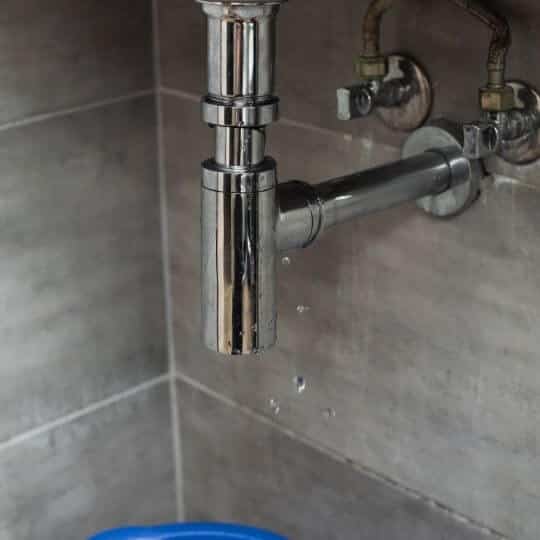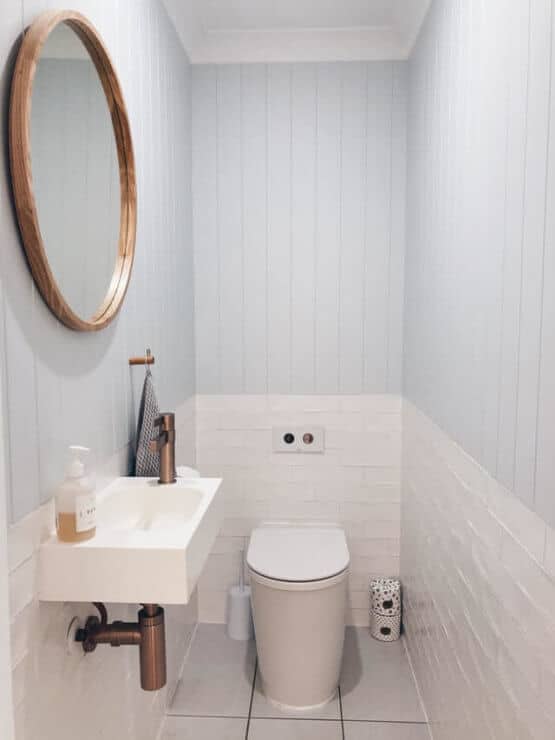If your plumbing system uses metal pipes, such as copper, galvanized steel, cast iron, or brass, you are bound to encounter rust at some point. The time it takes for the material to corrode is determined by a variety of factors, including the sort of material, the water acidity, and the compounds in your drinkable water. It’s crucial that you know how to remove rust from inside pipes if you want to keep your plumbing running smoothly.
Understanding the rusting process

Water is a universal solvent. With sufficient time, it will dissolve anything, including rock. And once the substance dissolves, it is made part of the water solution. The water pH changes as it absorbs dissolved particles and liquids. Water with a pH value less than 6.5 is considered acidic. The pH of rainwater is usually about 5.
Acidic water helps the corrosion process by dissolving and holding more solids. Conversely, deposits are left on items such as plumbing pipes and water fixtures when the pH of the water is high or (more alkaline).
Most people associate rust with iron or steel. When oxygen reacts with metal in the presence of water, whether liquid or gaseous, it causes corrosion. This type of iron rust can slowly eat away at the pipe, causing holes and eventually collapse.
“Sulfate and chloride corrosion are the most common causes of copper corrosion in buried copper pipelines. The soil is excessively high in sulfate and chloride compounds and is constantly damp in this scenario. Copper corrosion and pipe damage can result from this combination of circumstances.”
Acidic water will corrode all sorts of pipes. This water progressively dissolves everything it comes into contact with, including lead and copper, by leaching hard metals and compounds from the pipes. Flint, Michigan, is a well-known example of acidic water corrosion. [1]
When the city shifted to a water supply with lower pH values, the municipal plumbing pipes rusted quickly, contaminating the water with lead and hard metals.
What causes rusting of pipes?

Rust is the outcome of metals like iron and steel corroding or breaking down. Rust is a reddish-brown iron oxide generated by the redox interaction of oxygen and iron in water or in the air.[2]
Galvanized pipes are made of iron or steel and then coated with the molten zinc to keep them from rusting. The galvanizing flakes off with age, and the pipes rust. Rust eats away at the metal over time.
Galvanized pipes have a 50-year lifespan. Even when protected by the zinc covering, galvanized pipes corrode after years of continuous contact with water. The pipes rust on the inside, gradually enlarging the aperture in the tube as the rust builds up. It can also result in pinhole leaks, which can cause water damage. Corrosion can also introduce rust and other impurities into your drinking water.
Effects of rust
Rusty water pipes, whether inside or outside your home, are not only unsightly. Rust will chip away at your pipes till they leak, costing you money in repairs and wasting a lot of water.
Rust may find its way into your water, turning it dark and smelly (though it isn’t dangerous to humans or animals). However, if your rusted pipe problem isn’t too severe — that is, if you don’t have any leaks and the rust is just beginning – you can repair rusted pipes yourself.
PVC pipes are commonly used in plumbing systems for newly constructed homes these days. Although the former has largely superseded the latter, galvanized steel pipes can still be seen in older homes and buildings.
Light-colored clothing can be stained by the rust in the water.
To avoid damage, do not use the washing machine or hand-wash items in the rust-tainted water until it is clear again. While most plates and glasses will not be damaged by the rust in the water, light-colored pieces may be stained, especially if the glaze or finish has hairline cracks. Any unique or delicate dishes should not be washed in rust-colored water.
Determining if your pipes are rusted
Rust sediment could be coming from the main pipe or from the tubes inside your house. Running the outside faucet nearest to the main is a good way of finding the origin of the rust. This is generally in the front of the house, although if there is an alleyway, it could also be in the courtyard.
Allow two minutes for the water to run, then fill a clean cup with it and inspect for rust. If you discover rust in the water, it is most likely coming from the main supply; however, if the water is clear, the issue is most likely with the house’s plumbing.
You can’t see the rust since it grows up inside the pipes, so you’ll have to disassemble your plumbing to examine it. However, there are a few indicators of rust inside pipes. Rust can show up in a variety of ways, including:
- Water pressure loss: When the zinc coating on a galvanized steel pipe wears away, the interior begins to corrode and rust. The buildup of rust in the pipe eventually causes a blockage, reducing water flow and lowering water pressure.
- Uneven distribution of water: One or more fixtures may be affected depending on where the corroded pipe is placed in the plumbing network. If a line supplying a bathroom faucet is corroded, the pressure in that faucet will be low, even if the other fixtures appear to be okay. If a section of the house is served by a corroded pipe, all of the fixtures in that section will be affected.
- Water discoloration: Rust from the inside of the pipe flakes off and falls into the water running through the line, resulting in discolored water. As a result, water from faucets has an unpleasant brown color, a metallic taste and may even contain rusted metal flakes.
- Leaks: Galvanized steel pipes begin to leak after corrosion has progressed far enough. Fittings and threaded connections are frequently the first places where water leaks.
How to remove rust from inside pipes

It’s not easy to remove rust from within water pipes. However, it is critical to address the rust issue, which causes low water pressure, leaking, and pipe clogging.
It’s crucial to know how to remove rust from inside pipes in order to determine the best rust remover for pipes.
In case you have metal pipes in a large home or commercial facility, a pipe inspection can reveal whether they are corroding due to rust. You can also examine the visible lines and water fittings, such as faucets, throughout your building. It could suggest a problem with your water supply and plumbing pipes if they have stains or white stuff on them.
An epoxy liner may be the remedy to the rust and corrosion issues in your pipes. Pipeliners are introduced into existing plumbing pipes and allowed to cure. Once the coating has solidified, it stops water from contacting the metal of the host pipe, preventing future corrosion and extending the life of your pipes.
Rust-removers are chemical compounds that may altogether remove rust. There are numerous available alternatives, all of which are designed to provide a smooth surface for faster flow inside the pipes. The most delicate rust remover for lines is made to get rid of rust buildup in your pipes. The best rust remover for pipes in this category include CLR PRO Calcium, Lime, and Rust Remover for pipes. CLR Clear Pipes & Drains, and CLR Calcium, Lime & Rust Remover are also great options in this category.
Wire brush: Rust can be scrubbed away with wire brushes. These brushes resemble toothbrushes in appearance. This requires a lot of effort, but there are no chemicals involved. In the end, it will be just as effective as using a chemical rust remover. A fantastic option is the Supply Guru 3-Piece Wire Brush Detailing Set.
A wire brush and a chemical agent combination can also be effective. You may remove most of the rust with a wire brush then finish with a chemical rust remover. Some people believe this is important for some jobs where a single solution may not be sufficient.
Removing rust from cast iron pipes
Cast iron pipes are incredibly sturdy and built to last a long time. Cast iron, however, corrodes over time. When oxygen and water combine with iron, oxidation occurs, resulting in a rusty coating on the pipe. If you don’t remove the rust, it will gradually spread through the iron, causing cracks and overall weakness of the pipe. Fixing rusted cast iron tubes takes a lot of time and effort, but it improves the pipes’ appearance while also keeping them in good shape for longer.
Follow the methods below to remove rust from cast iron pipes:
- Fill a spray bottle with white vinegar halfway. Apply vinegar to the rusted sections of the pipe, then sprinkle salt on top and clean using a scouring pad. The vinegar’s acidity aids in the breakdown of rust, while the salt both degrades the rust and improves the scouring pad’s friction.
- If the softer approaches aren’t working, use a rust cleaner on the cast iron pipe. Because rust cleaners are highly acidic, use rubber gloves to avoid skin contact. For optimal performance and safety, follow all recommendations on the chemical box. Let the rust remover seep into the rust before using a cloth or a scrubbing pad to scrub it away. After the corrosion has been removed, use a sander or steel wool and cleanse the tube.
Removing rust from galvanized pipes

- Using Water softeners, vinegar, and Chemicals.
Water softeners can be used to remove rust from galvanized pipes. However, keep in mind that some water softeners may contain salts that exacerbate the corrosion issue. Consequently, you have to choose the appropriate water softener for your system.
Another way to remove iron buildup from galvanized water pipes is to soak them in vinegar. Chemicals like sodium hydroxide and sodium carbonate can also be used to eliminate iron buildups.
- Using the Electric Drill Method
Using an electric drill, remove the outer nozzles to reach inside the galvanized pipes. Keep a mild stream of water running through the pipework to lubricate the sediments as you slowly chip it off with the drill. Disconnect the pipelines if necessary and secure them while drilling, so they don’t rotate while you chip away at the iron buildup.
Remove iron buildup from T connections and elbows with a screwdriver. Reconnect the galvanized water pipes and cleanse the lines. If the sediments clog the tube, gently smash it from the outside until the blockage breaks and can be drained away.
Drain pipe clogged with rust

Draining rust-clogged pipes is a challenge. However, it is necessary in order to clean the insides of the lines and allow for adequate water flow. The obstructions inside the pipe may have become so deep that traditional techniques of drainage may no longer be effective.
As a result, a power snake of suitable size, power, and length might be recommended for clearing the way septic tanks. A power snake is a professional tool that can only be used by a qualified professional for safety purposes. It is easy to destroy the device if you don’t have the necessary training and experience to use it.
Final word
While it is feasible to remove rust from pipes, this can result in the material becoming thinner than it was previously. If the damage is extensive, it means that the tube is more likely to crack when you’re using it again. Under high water pressure, it might cause gas leakage or burst. As a result, if you know how to remove rust from inside pipes, you should carefully consider the available alternative options and make the right decision.

Michael Davis is a heating & plumbing expert who currently works as independent contractor in SC. He also writes for Plumbertip.
For almost 10 years he worked on various plumbing tasks across South Carolina.


